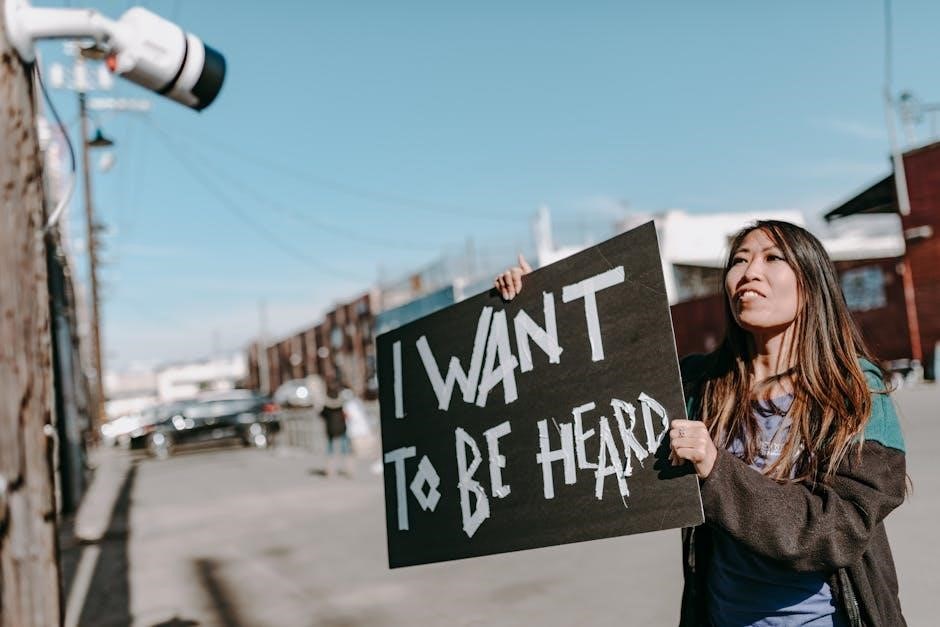peekskill usa: inside the infamous 1949 riots free pdf
The book Peekskill USA: Inside the Infamous 1949 Riots by Howard Fast explores the violent racial and political clashes in Peekskill, New York, during a civil rights concert.
It examines the events surrounding Paul Robeson’s concert, the subsequent riots, and their profound impact on American history, offering a detailed account of intolerance and activism.
1.1 Overview of the 1949 Peekskill Riots
The 1949 Peekskill Riots were a series of violent clashes in Peekskill, New York, sparked by a civil rights benefit concert featuring Paul Robeson. The first riot occurred on August 27, 1949, when a mob attacked attendees, injuring over 150 people. A second riot on September 4 further escalated tensions. These events highlighted deep racial and political divisions, drawing national attention and becoming a symbol of racial prejudice and intolerance in America during the late 1940s.
1.2 Significance of the Riots in American History
The Peekskill Riots of 1949 hold significant importance in American history as they exposed deep-seated racial and political tensions during the post-war era. The violence against civil rights activists and minorities underscored the persistent struggle for equality and justice. These events also highlighted the backlash against progressive movements, serving as a stark reminder of the challenges faced by activists like Paul Robeson. The riots remain a critical case study in understanding the intersection of race, politics, and social unrest in 20th-century America.
1.3 Purpose of the Article
This article aims to provide a comprehensive understanding of the 1949 Peekskill Riots, shedding light on their historical context, key figures, and lasting impact. By examining the events through the lens of Howard Fast’s book, the article seeks to educate readers on the racial and political tensions of the time. It also emphasizes the importance of learning from history to foster tolerance and equality. The free PDF availability ensures accessibility, making this pivotal moment in American history widely reachable for educational purposes.

Historical Context of the Peekskill Riots
The 1949 Peekskill Riots occurred amidst heightened racial and political tensions in post-war America, with civil rights activism clashing against rising anticommunist sentiment and segregationist ideologies.
2.1 Social and Political Climate of 1949 America
In 1949, America was in the grip of post-war tensions, marked by the rise of the Red Scare and McCarthyism. Racial segregation persisted, with civil rights activism gaining momentum. The political climate was polarized, with anticommunist sentiment fueling hostility toward progressive movements. Labor unions and civil rights organizations, like the Civil Rights Congress, faced increasing scrutiny. This volatile mix of social and political tensions created a backdrop for the Peekskill Riots, as racial and ideological conflicts erupted into violence.
2.2 The Role of the Civil Rights Congress
The Civil Rights Congress (CRC) was a legal defense organization founded in 1946, dedicated to fighting racial and political discrimination. It played a pivotal role in organizing the 1949 Peekskill concert featuring Paul Robeson, aiming to raise funds for its legal efforts. The CRC’s involvement highlighted the intersection of civil rights and labor activism, drawing support from progressive groups but also provoking opposition from anticommunist and racist factions, ultimately contributing to the violent confrontations during the riots.
2.3 Paul Robeson and His Activism
Paul Robeson was a renowned African-American singer, actor, and civil rights activist known for his powerful voice and unwavering commitment to social justice. He was a strong supporter of labor rights, civil rights, and anti-colonial causes, which made him a controversial figure in 1949 America. Robeson’s activism often clashed with the prevailing political climate, as he openly criticized racial inequality and advocated for workers’ rights.
His planned concert in Peekskill, New York, became a flashpoint for tension, as local opponents, fueled by racism and anticommunist sentiment, sought to disrupt the event. Robeson’s unwavering stance in the face of adversity symbolized the broader struggle for equality and justice during this tumultuous period.
2.4 The Location of Peekskill and Its Relevance
Peekskill, a small town in Westchester County, New York, became the unlikely setting for the 1949 riots due to its mix of industrial and rural characteristics. The town’s proximity to New York City made it a hub for labor movements, while its suburban location also harbored deep-seated racial and political tensions. The choice of Peekskill for Paul Robeson’s concert was strategic, aiming to unite workers and activists, but it ultimately exposed the region’s underlying prejudices and social divides.
Key Figures Involved in the Riots
Paul Robeson, a prominent singer and activist, was the catalyst for the riots. Howard Fast, author of Peekskill USA, and Pete Seeger, a folk singer, were also central figures.
3.1 Paul Robeson: The Catalyst for the Riots
Paul Robeson, a prominent African-American singer and activist, was the catalyst for the 1949 Peekskill riots. His concert, a benefit for the Civil Rights Congress, faced opposition from local groups, including the American Legion. The event drew violent mobs, leading to attacks on attendees. Robeson’s advocacy for equality and justice made him a target, symbolizing the era’s racial and political tensions.
3.2 Howard Fast: Author and Eyewitness
Howard Fast, a renowned author, played a pivotal role in documenting the Peekskill riots. As the master of ceremonies at Paul Robeson’s concert, he witnessed the violence firsthand. His book, Peekskill USA, provides a detailed account of the events, offering insights into the social and political climate of the time. Fast’s involvement and eyewitness testimony add depth to the historical narrative, making his work a crucial resource for understanding the riots’ significance.
3.3 Pete Seeger and Other Performers
Pete Seeger, a legendary folk singer and activist, was a key figure in the Peekskill riots. Alongside Paul Robeson, Woody Guthrie, and other artists, Seeger supported the civil rights benefit concert. His involvement highlighted the intersection of music and activism. Despite the violence, these performers symbolized resistance against racial and political oppression. Their courage and artistry left a lasting impact on the movement, as documented in Howard Fast’s Peekskill USA, now available as a free PDF for readers to explore.
3.4 The American Legion and Local Veterans
The American Legion and local veterans played a significant role in the Peekskill riots, opposing the civil rights concert. They viewed the event as communist-aligned due to Paul Robeson’s associations. Their actions, including violent protests, were aimed at stopping the concert. The Legion’s involvement underscored the deep racial and political tensions of the time, as detailed in Howard Fast’s Peekskill USA, available for free in PDF format.

The First Riot: August 27, 1949
The concert was violently disrupted by mobs opposing Paul Robeson’s performance, leading to widespread injuries and chaos. The free PDF details the event’s intensity and aftermath.
4.1 The Announced Concert and Its Opposition
The concert, featuring Paul Robeson, was announced as a benefit for the Civil Rights Congress, sparking immediate opposition from local groups. The American Legion and veterans’ organizations viewed Robeson’s leftist affiliations and civil rights activism as a threat, organizing protests. Despite threats, organizers proceeded, believing in the event’s importance. The free PDF details how the concert became a flashpoint for racial and political tensions, leading to the first riot.
4.2 The Mob Attack and Violence
On August 27, 1949, a violent mob attacked attendees of the concert, targeting African Americans and Jews. The free PDF reveals how the mob, fueled by racial hatred and political extremism, threw stones, and vandalized vehicles. Over 150 people were injured, and the event descended into chaos. The attack highlighted the deep-seated prejudices of the time and the dangers of unchecked intolerance, leaving a lasting scar on the community and civil rights efforts. The violence marked the first of two devastating riots in Peekskill.
4.3 Eyewitness Accounts and Testimonies
Eyewitnesses described the August 27 riot as chaotic and terrifying. Howard Fast, who was present, recounted the violent mob attacking concertgoers. Attendees reported being pelted with rocks and beaten, with many fleeing in fear. One eyewitness noted, “At 8:15, I left the defense lines on the bridge and made my way through the mob.” These testimonies highlight the brutality and racial hatred that defined the event, providing a harrowing glimpse into the violence and its impact on those involved.
4.4 Immediate Aftermath and Injuries
Following the August 27 riot, more than 150 people were injured, many seriously. The violence left numerous concertgoers battered, with broken bones and head injuries. Eyewitnesses described the scene as devastating, with bloodied victims seeking refuge. Local hospitals were overwhelmed, treating the wounded for hours. The immediate aftermath revealed the shocking scale of the brutality, underscoring the deep racial divisions and intolerance that fueled the violence. The injuries served as a grim reminder of the event’s severity and lasting impact on the community.

The Second Riot: September 4, 1949
The second riot occurred on September 4, 1949, after organizers reattempted the concert with enhanced security. Labor unions played a significant role, but violence erupted again, leaving many injured and deepening community tensions.
5.1 The Reorganized Concert and Security Measures
After the August 27 violence, organizers, supported by labor unions, reattempted the concert on September 4, 1949, with enhanced security. The event was better planned, featuring Paul Robeson, Pete Seeger, and others, aiming to assert civil rights and solidarity. Despite precautions, the second riot erupted, revealing the deep-seated racial and political tensions. The reorganized effort highlighted the community’s resilience but also the persistent threat of violence, underscoring the volatile climate of the time.
5.2 The Second Wave of Violence and Its Impact
The second riot on September 4, 1949, saw renewed violence despite heightened security measures. Mobs attacked concertgoers, resulting in injuries and property damage. This escalation shocked the nation, drawing attention to Peekskill as a symbol of racial and political conflict. The violence intensified public debate on civil rights and labor unity, leaving a lasting mark on American social history and highlighting the challenges faced by activists in the post-war era.
5.3 The Role of Labor Unions in the Second Riot
Labor unions played a pivotal role in the second riot by organizing and securing the re-staged concert. Workers from New York City unions provided protection, ensuring the event proceeded despite ongoing threats. Their involvement highlighted the strong alliance between labor rights and civil rights movements. The unions’ solidarity demonstrated their commitment to combating racial prejudice and political extremism, making them a crucial force in resisting the violence and intimidation faced during the Peekskill riots.
5.4 The Final Confrontation and Its Consequences
The final confrontation during the second riot in Peekskill resulted in significant injuries and arrests, with over 150 people harmed. The violence led to legal actions and public outcry, exposing deep-seated racial tensions. The aftermath saw increased scrutiny of local authorities and a renewed focus on civil rights activism. The events of September 4, 1949, left a lasting impact on the community and highlighted the urgent need for social change in America.

Aftermath and Consequences of the Riots
The Peekskill riots led to legal investigations, public outrage, and a heightened awareness of racial tensions. The events marked a turning point in the civil rights movement.
6.1 Legal Actions and Investigations
Following the riots, legal actions were pursued, with over 80 victims filing lawsuits against Westchester County officials for negligence. The ACLU and local authorities conducted investigations, revealing systemic failures. These legal efforts aimed to hold accountable those responsible for the violence and ensure justice for the injured. The cases highlighted the need for stronger protections against racial violence and governmental accountability in such incidents.
6.2 Public Reaction and Media Coverage
The Peekskill riots sparked widespread public concern and extensive media coverage. Newspapers and journals highlighted the violence, drawing attention to racial tensions and political extremism. The media played a crucial role in documenting the events, with outlets like UE NEWS covering the aftermath. Public reaction ranged from outrage to solidarity, with many viewing the riots as a stark reminder of racial prejudice. The incident also fueled debates about civil rights and labor movements, cementing its place in historical discourse.
6.3 The Beating of Eugene Bullard
Eugene Bullard, a trailblazing African-American combat pilot, was brutally beaten during the Peekskill riots. His assault symbolized the racial violence and intolerance prevalent during the events. Bullard’s beating drew significant attention, highlighting the broader racial tensions of the time. The incident remains a poignant example of the human cost of prejudice and the ongoing struggle for civil rights in America.
6.4 Long-term Effects on the Community
The Peekskill riots left lasting scars, deepening racial and social divisions in the community. The violence deterred future civil rights events, fostering an atmosphere of fear and mistrust. Economically, the area suffered as businesses declined, and the town’s reputation was tarnished. The riots also galvanized labor unions and civil rights groups, sparking long-term activism. The legacy of Peekskill remains a powerful reminder of the consequences of intolerance and the importance of unity in overcoming adversity.

The Legacy of the Peekskill Riots
The Peekskill riots exposed deep racial and political tensions, becoming a symbol of resistance against injustice. They inspired civil rights activism and remain a vital historical lesson.
7.1 Impact on Civil Rights and Labor Movements
The Peekskill riots significantly influenced civil rights and labor movements by highlighting racial prejudice and sparking widespread outrage. They unified activists, prompting stronger alliances between labor unions and civil rights organizations. The events drew national attention to systemic racism and emboldened advocates for equality, inspiring future protests and legislative reforms. The collaboration between workers and civil rights groups during the riots demonstrated the power of collective action, leaving a lasting legacy in the fight for justice and equality.
7.2 The Riots as a Symbol of Racial Prejudice
The Peekskill riots symbolize the deep-seated racial prejudice prevalent in post-war America. The violent attacks on African Americans and Jews underscored the pervasive intolerance of the era. The riots targeted a civil rights concert, highlighting the intersection of race and political activism. They became a stark reminder of the systemic racism embedded in American society, illustrating how fear and bigotry could escalate into violence. The events served as a catalyst for broader conversations about racial equality and justice.
7.3 Educational and Historical Significance
The Peekskill riots serve as a critical case study for understanding racial and political tensions in post-war America. They highlight the dangers of intolerance and the importance of civil rights activism. The events provide valuable educational insights into the intersection of race, labor, and politics. Howard Fast’s book offers a detailed account, making it a vital resource for historians and educators. By examining these riots, students can grasp the complexities of American history and the ongoing struggle for equality and justice.
7.4 Commemoration and Anniversary Events
The Peekskill riots are remembered through annual events and documentaries, such as filmmaker Jon Scott Bennett’s work, which highlights the historical significance of the 1949 violence. Anniversaries, like the 75th in 2024, feature discussions, screenings, and reflections on the events. These commemorations aim to educate the public and honor the victims, ensuring the lessons of Peekskill are not forgotten. They also serve as a reminder of the ongoing fight against racial and political intolerance in America.

Cultural and Artistic Responses to the Riots
Artists and writers responded to the Peekskill riots through music, literature, and film, using their work to protest racial injustice and preserve the historical memory of the events.
8.1 Music and Art as a Form of Protest
Music and art played pivotal roles in responding to the Peekskill riots, with artists like Pete Seeger and Paul Robeson using their craft to protest racial injustice and political oppression. Their performances and works served as powerful tools to highlight the atrocities, inspiring solidarity and raising awareness about civil rights. The riots also inspired literary and visual art, creating a lasting cultural impact that continues to educate and provoke reflection on the events of 1949.
8.2 Literary Works Inspired by the Riots
Literary works inspired by the Peekskill riots include Howard Fast’s book, which provides a firsthand account and analysis of the events. Other writers and poets also drew inspiration, crafting works that reflected the social tensions and racial conflicts of the time. These writings serve as a testament to the riots’ impact, preserving their historical significance and offering insights into the broader civil rights struggle of the era.
8.3 Documentary Films and Media Coverage
Documentary films like The Riot and a docuseries by filmmaker Jon Scott Bennett highlight the Peekskill riots, offering visual narratives of the violence and its aftermath. Media coverage from outlets like UE NEWS and local newspapers documented the events, providing firsthand accounts and raising public awareness. These films and reports serve as vital historical records, preserving the story of the riots and their impact on civil rights and labor movements, ensuring future generations can learn from this pivotal moment.
8.4 The Role of Artists in Preserving History
Artists played a crucial role in preserving the history of the Peekskill riots through their work. Filmmakers, writers, and musicians documented the events, ensuring their legacy endured. Howard Fast’s book, Pete Seeger’s music, and Jon Scott Bennett’s documentaries are examples of how art transformed the riots into a lasting narrative. These creative efforts not only educated the public but also honored the victims and activists, cementing the riots’ place in historical memory and inspiring future generations to fight for justice and equality.

The Free PDF and Its Availability
The free PDF of Peekskill USA: Inside the Infamous 1949 Riots by Howard Fast is readily available online, allowing readers to access this historical account effortlessly.
9.1 Accessing the Book “Peekskill USA: Inside the Infamous 1949 Riots”
The book Peekskill USA: Inside the Infamous 1949 Riots by Howard Fast is available for free in PDF format, accessible through various online platforms and digital archives.
Readers can download the PDF directly from multiple sources, ensuring easy access to this historical account of the 1949 riots and their significance in American history.
The digital version provides a convenient way to explore the events, offering insights into racial tensions, activism, and their lasting impact on civil rights movements.
Download the free PDF to uncover the truth behind this pivotal moment in history and its relevance today.
9.2 The Importance of Free Educational Resources
Free educational resources like the Peekskill USA: Inside the Infamous 1949 Riots PDF play a vital role in democratizing knowledge and promoting historical awareness.
By making such books accessible without cost, they enable students, researchers, and the general public to explore critical historical events without financial barriers.
This accessibility fosters a deeper understanding of social justice movements and encourages informed discussions about race, activism, and civil rights.
Free resources empower individuals to engage with history, fostering empathy and learning from past struggles to build a more equitable future;
9.3 The Role of Digital Platforms in Preserving History
Digital platforms have revolutionized the preservation and dissemination of historical events like the Peekskill riots, ensuring their legacy endures for future generations.
By hosting free PDFs of books such as Peekskill USA: Inside the Infamous 1949 Riots, these platforms provide global access to firsthand accounts and analyses.
This digital accessibility not only educates the public but also safeguards historical records from fading into obscurity, fostering a collective memory of significant events.
Digital archives serve as invaluable tools for researchers and educators, maintaining the relevance of history in an increasingly digital world.
9.4 Benefits of Reading the Book in PDF Format
Reading Peekskill USA: Inside the Infamous 1949 Riots in PDF format offers unparalleled convenience and accessibility, allowing readers to engage with the text anytime and anywhere.
The digital version preserves the original content’s integrity while enabling features like keyword searches and adjustable font sizes for an enhanced reading experience.
Additionally, the free PDF ensures that this critical piece of history reaches a broader audience, promoting education and awareness about the Peekskill riots’ significance.
It serves as a valuable resource for students, researchers, and history enthusiasts alike, fostering a deeper understanding of the event’s impact on civil rights and social justice movements.
The Peekskill riots of 1949 remain a stark reminder of racial prejudice and political tensions in America, underscoring the importance of learning from history to foster equality and justice.
10.1 Final Thoughts on the Peekskill Riots
The Peekskill riots of 1949 serve as a poignant reminder of America’s complex history, highlighting the dangers of racial prejudice and political extremism. These events, marked by violence against civil rights activists and supporters of Paul Robeson, underscore the resilience of those who fought for equality. The riots also reveal the deep societal divisions of the time, emphasizing the need for ongoing efforts to combat intolerance and promote unity. Reflecting on these events today, we honor the courage of those who stood for justice and reaffirm our commitment to a more equitable society.
10.2 The Importance of Learning from History
Understanding the Peekskill riots offers valuable lessons on combating prejudice and extremism. These events highlight the dangers of intolerance and the importance of unity. By examining the past, we can avoid repeating mistakes and foster a more inclusive society. The free PDF, Peekskill USA: Inside the Infamous 1949 Riots, serves as a vital educational tool, ensuring future generations grasp the significance of these events and their relevance to ongoing struggles for justice and equality.
10.3 Encouragement to Explore the Free PDF
Downloading the free PDF of Peekskill USA: Inside the Infamous 1949 Riots offers a unique opportunity to delve into a pivotal moment in American history. This book provides a detailed narrative of the riots, their causes, and their consequences, making it an essential resource for understanding racial and political tensions of the era. By exploring this PDF, readers gain insights into the struggles of the past, fostering a deeper appreciation for the ongoing fight for justice and equality. It is a must-read for anyone interested in history, civil rights, and social justice.